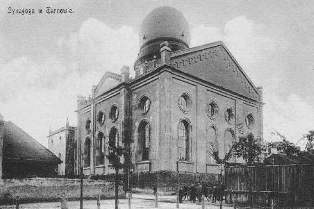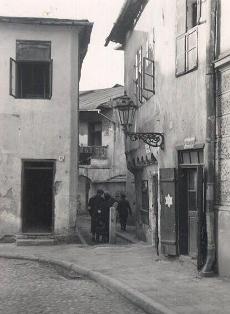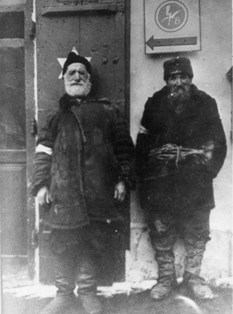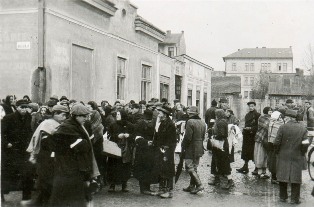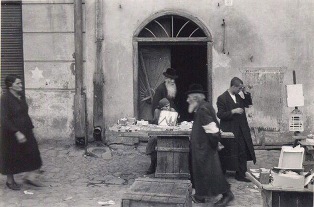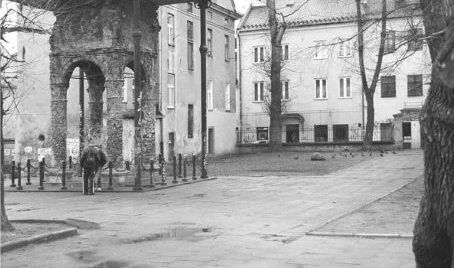Tarnow Ghetto
Tarnow is a town in southern Poland, approximately 70 km east of Krakow. Before the war around 25,000 Jews lived there, around 50% of the population. When the Germans bombed Tarnow for the first time on 3 September 1939, many of its Jews fled further east, while a large influx of refugees from elsewhere in Poland moved into the town.
The Germans occupied Tarnow on 8 September 1939, and they immediately started confiscating Jewish property and capturing men in the streets for forced labour.
On 9 November 1939 Tarnow’s synagogues and prayer houses were set on fire and later demolished. In the same month a Judenrat was established. Its members made great efforts to assist the Jewish population.
During Passover 1940, the Nazis replaced them with another Judenrat. On 18 December 1939 Tarnow’s Jews were ordered to wear a special badge and to hand in valuables such as jewellery or foreign currency on pain of death.
The first transport of Polish prisoners to Auschwitz departed from the old mikvah building (ritual Jewish bath) at Boznic St. in Tarnow on 14 June 1940. These 728 prisoners (708 Poles and 20 Jews) from the Deutsche Strafanstalt (prison) were the first transport to the camp. On arrival they were tattooed with the numbers 31 to 758. (Numbers 1 to 30 were allocated to German prisoner functionaries brought from existing camps to assist Hoess and his staff in setting up the camp).
Among these first group of prisoners were Tadek Szwed, Djunio Beker, Romek Trojanowski Edek Galinski and Wieslar Kielar. Wieslaw Kielar was given the number 290, who described their arrival at Auschwitz:
“The name of the place, written in large letters on the station building is Auschwitz. Someone explains that this is Oswiecim. Some dump or other. Presumably we are being shunted into a siding since the train curves sharply so that the wheels squeal remorselessly.
We sit still, our train seems to have hiccups – now it moves a few yards, now it stops. From the other side of the window come the sounds of voices shouting in German, of feet running and stamping. Suddenly the doors of the carriages are flung open. Someone at the platform shouts at the top of his voice, “Everybody Out.” Our escorts assist us to climb out of the train, in their own way, they bring the butts of their carbines down on our backs with resounding blows.
We all dash like mad towards the one and only exit, and one by one we jump down from the high carriage and land directly at the feet of scores of SS men, they are lined up in rows leading towards a high fence which encircles a large building.”
The establishment of the Tarnow Ghetto was formally announced in March 1941. It remained open for 3 months. At the beginning of June 1941 Jews from the surrounding district were relocated to Tarnow, and the population of the ghetto rose to 40,000.
The Jews had very little food, as the German Supply Department did not issue them with sufficient rations and they were forbidden on pain of death to smuggle extra food into the ghetto. As a result a state of famine prevailed in the ghetto.
The First Aktion - June 1942
The first "aktion" against the Jews of Tarnow was carried out In June 1942. The Higher SS- und Polizeiführer for the Generalgouvernement, SS-Obergruppenführer F.W. Krüger, visited Tarnow and gave instructions to the local SD and Sipo authorities concerning the forthcoming operations. On 9 June 1942 the Jews were ordered by proclamation to report the following day to Kaplanowka Square for registration. The papers of Jews who could prove they were employed on essential war work were stamped "SD"; the documents of the others were marked with the letter "K".
Subsequently the Judenrat was ordered to surrender for deportation all those whose papers had been stamped with a "K". When the Germans entered the Judenrat premises and requested the lists of Jews to be deported, Paul Reiss declared he would be the first to go and was shot on the spot. Several other members of the Judenrat were also killed.
Due to the enormous task represented by the first “Aktion”, the security services sought assistance from the local and district police, a company of Waffen-SS (commanded by SS-Hauptsturmführer Klienow, stationed at Debica Training Camp), the Sonderdienst (Special Services), the Baudienst (Polish pioneer service) and several employees of the Tarnow labour exchange.
On the morning of 11 June 1942, following a speech by Klee, commander of the criminal police, the SS men were issued rations of alcohol and they and the Baudienst, armed with axes, broke down the locked doors of Jewish houses. Jews in possession of papers stamped with a "K" or with no papers were taken away or killed on the spot. Children were murdered by having their heads smashed against walls or pavements.
Groups of Jews were dragged to a nearby forest and machine-gunned there; others were shot by the fence of the Jewish cemetery. Several hundred Jews were killed in the steam bath establishment at Czacki school, where they were choked by steam.
During the “Aktion” 7,000 Jews were killed in Tarnow itself and in the Buczyna forest near Zbylitowska Gora, where they were buried in large pits. While these events were taking place, 11,500 other Jews were marched to the railway station, where they were loaded into railway trucks and deported to certain death in the gas chambers at Belzec.
On 20 June 1942 the remaining Jews in Tarnow were ordered to enter a special ghetto enclosure. The ghetto was fenced in by a 2 m high wooden wall topped with barbed wire. The surviving Jews were forbidden to leave the ghetto without approval. Other Jews began to pour into the ghetto from surrounding areas.
On 24-25 July 1942 the Jews were ordered out of their houses. They all had to remove their shoes and, barefoot, were driven with rifle butts and whips into the market square. Children were taken from their parents to a nearby shed and shot. Some Jews were selected for forced labour; the rest were deported to Belzec. This second Aktion was conducted on direct orders from F.W. Krüger, and the inhabitants were notified by an announcement by Dr Pernutz, deputy town major. The Aktion targeted the old, those sick and unfit for work, women and children. It was also known as the Kinderaktion ("Children action") because of the large numbers of children killed.
At 7 a.m. on 10 September 1942, all Tarnow’s remaining 10,000 Jews had to present themselves at the Magdeburger Platz, the assembly square of the ghetto. This operation was a repeat of the first deportation.
In charge was Gestapo chief Palten. The Jews were selected for either deportation or work. The selection was again accompanied by acts of brutality. Jews were made to kneel on the ground for many hours and shot dead for no apparent reason. SS officers Oppermann and Libor displayed particular cruelty. The Jews were then made to march in double file past a table near the main gate of the ghetto which was manned by the Gestapo. Those able to show permits with the seal of the Gestapo were sent to one side; those whose permits had no seal were sent to the other side. Jews were shot dead on the slightest pretext.
Even the wives and children of those selected to live were not spared; they were brutally taken away by the Gestapo and loaded onto trucks.
Parents who refused to give up their children were simply shot on the spot. A local taxi driver was ordered to organize vehicles to take several hundred old and sick Jews to the cemetery, where the victims were made to undress and then shot. The majority of Jews selected for deportation were taken from the ghetto during the Aktion to a barracks on the outskirts of the town, near the railway station. The selection of other Jews from the ghetto continued for further two days.
The “Aktion” was completed on 12 September 1942, and the Jews in the barracks were led to the station, loaded into cattle wagons and taken to Belzec, where they were all killed. The number of Jews deported or killed in the town and at the cemetery is estimated at 10,000.
In October 1942 the ghetto was divided into two parts. Section A was organised as a forced labour camp with separate quarters for men and women. Its commander was SS-Hauptsturmführer Blacher, and it housed Jewish men, women and children aged over 12 years, all of whom were organized into working squads. This section was known as Zwangsarbeitslager Tarnow. Section B held all Jews who did not work and Jewish laborers with large families. Its commander was SS-Oberscharführer Grunoff. The Jews were not allowed to move from one ghetto to the other.
On 15 November 1942 another Aktion took place in Tarnow. SS-Hauptsturmführer Palten was again in charge. A significant number of Ghetto B inhabitants decided to hide in shelters, basements and other places to avoid detection.
The Ghetto A Jews left for work. The Ghetto B Jews were ordered to report to the Magdeburger Platz, where they were made to surrender all valuables. They were ordered to kneel down while Gestapo officers Palten, Rommelmann, Grunow, Jeck, Oppermann, Gaa and Libor checked their documents in a brutal fashion.
Gestapo officer Gaa went with the head of the Jewish order police, Bienenstock, to the tailor’s workshop administered by Lauer, where several Jews were working. Among this group of Jewish workers were David Fromowicz and his wife Chaja, who were both arrested and taken to the collecting point on the square.
At about midday the selected 2,500 Jews at the square were lined up in columns and marched under guard to the station, where they were loaded into goods wagons which were then closed and sealed with lead. The train left Tarnow station at about 6 p.m., stopping at Rzeszow station where other wagons loaded with Jews were coupled to the train. At midnight the train left Rzeszow and headed for Belzec via Rawa Ruska.
In the region of Rawa Ruska David and Chaja Fromowicz, with other Jews, climbed through the air-vents in their wagon and jumped clear while the train was moving. They returned to the Tarnow ghetto.
In early January 1943 SS-Oberscharführer Blache took over command of the ghetto. This mainly involved supervising the Jewish labour force and safeguarding the property left behind by the deported Jews. In the summer of 1943 there were still about 9,000 Jews in sections A and B of the ghetto.
The Final Liquidation - September 1943
In the middle of August 1943 a conference was held in the office of SS-Obergruppenführer Wilhelm Koppe in Krakow, who had replaced F.W.Krüger as HSSPF for the Generalgouvernement. SS-Oberführer Scherner presided over the conference. It was announced that a fourth Aktion would take place in early September 1943 to liquidate the Tarnow ghetto.
Scherner took a particularly sinister and deadly decision by placing SS-Hauptsturmführer Amon Göth, the liquidator of the ghettos in Lublin, Rzeszow, Bochnia, Przemysl, and Krakow, and the Szebnie camp, in charge of the operation.
At the end of August 1943 a further conference was held to fine-tune the plans for the final liquidation of the ghetto. 200 Jewish men and 100 Jewish women were to remain in the ghetto to serve as a cleaning-up party. 2,000 Jews from the Madritsch clothing factory were transferred to Plaszow. The approximately 6,000 remaining Jews were to receive "special treatment" in Auschwitz-Birkenau.
On the morning of 3 September 1943 SS/SD and other forces surrounded the ghetto. The working Jews from Ghetto A paraded as on any other day, the Jews in Ghetto B also gathered in the Magdeburger Platz. The Jewish clearing command was organised and made to parade in the grounds of the Singer crate factory, which proved to be extremely suitable for the purpose because it was already fenced. A sentry was posted at the entrance to the factory grounds to prevent Jews selected for deportation from slipping into the rear cleaning party. Next followed the selection of Jews from Ghetto A for employment at the Plaszow forced labour camp.
Many Jews realised the Jews in the Singer factory grounds were not slated for immediate deportation and tried to join them. Göth and his colleagues had anticipated this move, and set about ill-treating the Jews who attempted to escape. Göth walked through the rows of Jews with his pistol drawn, shouting and dealing out blows. He immediately shot dead some Jews who were slow to act. He hit a Jewish woman called Zimmermann so hard that she fell to the ground, dead. Jews were shot out of hand and their bodies strewn across the square. Jews hiding in their houses were shot on the spot. That same afternoon, Jews were led in groups from Magdeburger Platz to the railway station and loaded into goods wagons, 160 Jews per wagon. The air-vents of the wagons were closed and wooden planks nailed over them. Many Jews died of suffocation en route to Auschwitz, due to the lack of ventilation.
About 50 Jews who had attempted to smuggle small children with them out of the ghetto in rucksacks were taken out of the transport and driven back by lorry to the ghetto, where Göth and other SS-men started shooting at them. They were all killed. The Nazi occupation of Tarnow ended on 18 January 1945 when the Soviet Army entered the city.
Trials
Many members of the SS/SD and auxiliary forces, responsible for the extermination of the Tarnow Jews, had died before investigations were launched in the 1960ies. However, three major former members of the Sicherheitspolizei-Außenstelle (Security Police - Field Office) were charged with crimes in Tarnow.
Karl Oppermann was accused of the murder of at least 156 members of the Jewish community of Tarnow and the deportation of about 23,000 Jews to the extermination camps of Belzec and Auschwitz.
Gaa was charged with compliance with execution orders involving the death of at least 25 members of the Jewish community of Tarnow and the deportation of about 8,500 Jews to the extermination camps of Belzec and Auschwitz.
Libor was accused of compliance with execution orders involving the death of at least 13 members of the Jewish community of Tarnow and the deportation of about 13,600 Jews to the extermination camps of Belzec and Auschwitz.
Sources:
Robin O’Neil - Selected extracts from unpublished research on Belzec and the Ghettos of Galicia
Anus Mundi – Five Years in Auschwitz by Wieslaw Kielar, published by Penguin Books 1982
Encyclopedia of The Holocaust – published by Macmillan Publishing Company New York 1990
Holocaust Historical Society & Private Collections
Private collections CW & LB
Copyright CW H.E.A.R.T 2007 | 